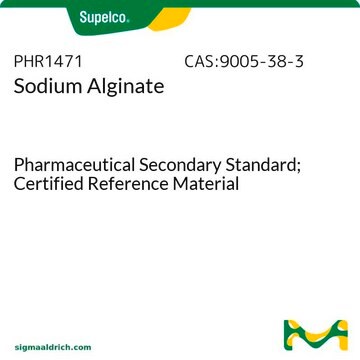The carboxylic acid content is not determined for this product.
A1112
Alginic acid sodium salt from brown algae
low viscosity
Synonym(s):
Algin, Sodium alginate
About This Item
Recommended Products
biological source
algae (brown)
Quality Level
form
powder
color
white to brown
viscosity
4-12 cP, 1 % in H2O(25 °C)
solubility
water: 10 mg/mL, cloudy to hazy, faintly yellow
storage temp.
2-8°C
SMILES string
[Na+].[O-]C(=O)C1O[C@H]([C@H]([C@H]([C@@H]1O)O)O)O
InChI
1S/C6H10O7.Na/c7-1-2(8)4(5(10)11)13-6(12)3(1)9;/h1-4,6-9,12H,(H,10,11);/q;+1/p-1/t1-,2-,3-,4?,6+;/m0./s1
InChI key
MSXHSNHNTORCAW-MPGIDXPLSA-M
Looking for similar products? Visit Product Comparison Guide
Application
Other Notes
Storage Class
11 - Combustible Solids
wgk_germany
WGK 1
flash_point_f
Not applicable
flash_point_c
Not applicable
Choose from one of the most recent versions:
Certificates of Analysis (COA)
Don't see the Right Version?
If you require a particular version, you can look up a specific certificate by the Lot or Batch number.
Already Own This Product?
Find documentation for the products that you have recently purchased in the Document Library.
-
What is the carboxylic acid content of this polymer ?
1 answer-
Helpful?
-
-
How is shipping temperature determined? And how is it related to the product storage temperature?
1 answer-
Products may be shipped at a different temperature than the recommended long-term storage temperature. If the product quality is sensitive to short-term exposure to conditions other than the recommended long-term storage, it will be shipped on wet or dry-ice. If the product quality is NOT affected by short-term exposure to conditions other than the recommended long-term storage, it will be shipped at ambient temperature. As shipping routes are configured for minimum transit times, shipping at ambient temperature helps control shipping costs for our customers. For more information, please refer to the Storage and Transport Conditions document: https://www.sigmaaldrich.com/deepweb/assets/sigmaaldrich/marketing/global/documents/316/622/storage-transport-conditions-mk.pdf
Helpful?
-
-
How can I determine the shelf life / expiration / retest date of this product?
1 answer-
If this product has an expiration or retest date, it will be shown on the Certificate of Analysis (COA, CofA). If there is no retest or expiration date listed on the product's COA, we do not have suitable stability data to determine a shelf life. For these products, the only date on the COA will be the release date; a retest, expiration, or use-by-date will not be displayed.
For all products, we recommend handling per defined conditions as printed in our product literature and website product descriptions. We recommend that products should be routinely inspected by customers to ensure they perform as expected.
For products without retest or expiration dates, our standard warranty of 1 year from the date of shipment is applicable.
For more information, please refer to the Product Dating Information document: https://www.sigmaaldrich.com/deepweb/assets/sigmaaldrich/marketing/global/documents/449/386/product-dating-information-mk.pdfHelpful?
-
-
What is the ratio of mannuronic acid to guluronic acid in product A1112, Alginic acid sodium salt?
1 answer-
This product is not tested on a lot by lot basis for MG ratio. However, historical data indicates that this material is 60-70 % Mannuronic acid and 30-40 % Guluronic acid resulting in an M/G ratio of 1.56. The degree of polymerization is 400-600. Molecular weight: approx. 30 000 - 100 000.
Helpful?
-
-
WHAT IS THE PURITY OF THE PRODUCT NO. A1112? Can you provide the NMR spectra of this product?
1 answer-
The purity of this product is not a determined. An NMR of the material has not been performed. Please navigate to the ‘DOCUMENTATION’ section of the Product Detail Page to access a sample or lot-specific Certificate of Analysis:
https://www.sigmaaldrich.com/product/sigma/a1112#product-documentationHelpful?
-
-
What is the endotoxin level of this product?
1 answer-
This product is not currently tested for endotoxin. Please see the link below to review the specification sheet and the tests performed on this product: https://www.sigmaaldrich.com/specification-sheets/805/253/A1112-BULK________SIGMA____.pdf
Helpful?
-
-
What taxa of brown algae are used for this product?
1 answer-
This product is extracted from a seaweed from Norway. Further taxonomic classification is not determined.
Helpful?
-
-
Does this product create a low or high stiffness gel?
1 answer-
This product is not tested for gelation or gel strength. Alginate forms a gel in the presence of cations. Typically CaCl2 is used to initiate gel formation. Increasing the concentration of calcium will result in a more firm gel. Calcium chloride may be added at a range of 0.1M to 0.5M, with gel strength increasing with the CaCl2 concentration.
Helpful?
-
-
Which is the maximum solubility in water of the alginate?
1 answer-
Per our specifications, we test solubility in water at 10 mg/ml. We do not test the maximum amount that can be dissolved. When used as a gelling agent for plant tissue culture, Alginic acid is prepared at 1.75 – 4.0 % (w/v) in a low calcium buffered medium. At these concentrations, following stirring, the alginate will completely dissolve yielding a clear solution. It can then be filter sterilized or autoclaved. Gelation occurs in the presence of cations - typically CaCl2.
Helpful?
-
-
What is the percentage of guluronic, mannuronic monomers?
1 answer-
The percentage of guluronic and mannuronic monomers are not determined for this product.
Helpful?
-
Active Filters
Our team of scientists has experience in all areas of research including Life Science, Material Science, Chemical Synthesis, Chromatography, Analytical and many others.
Contact Technical Service




